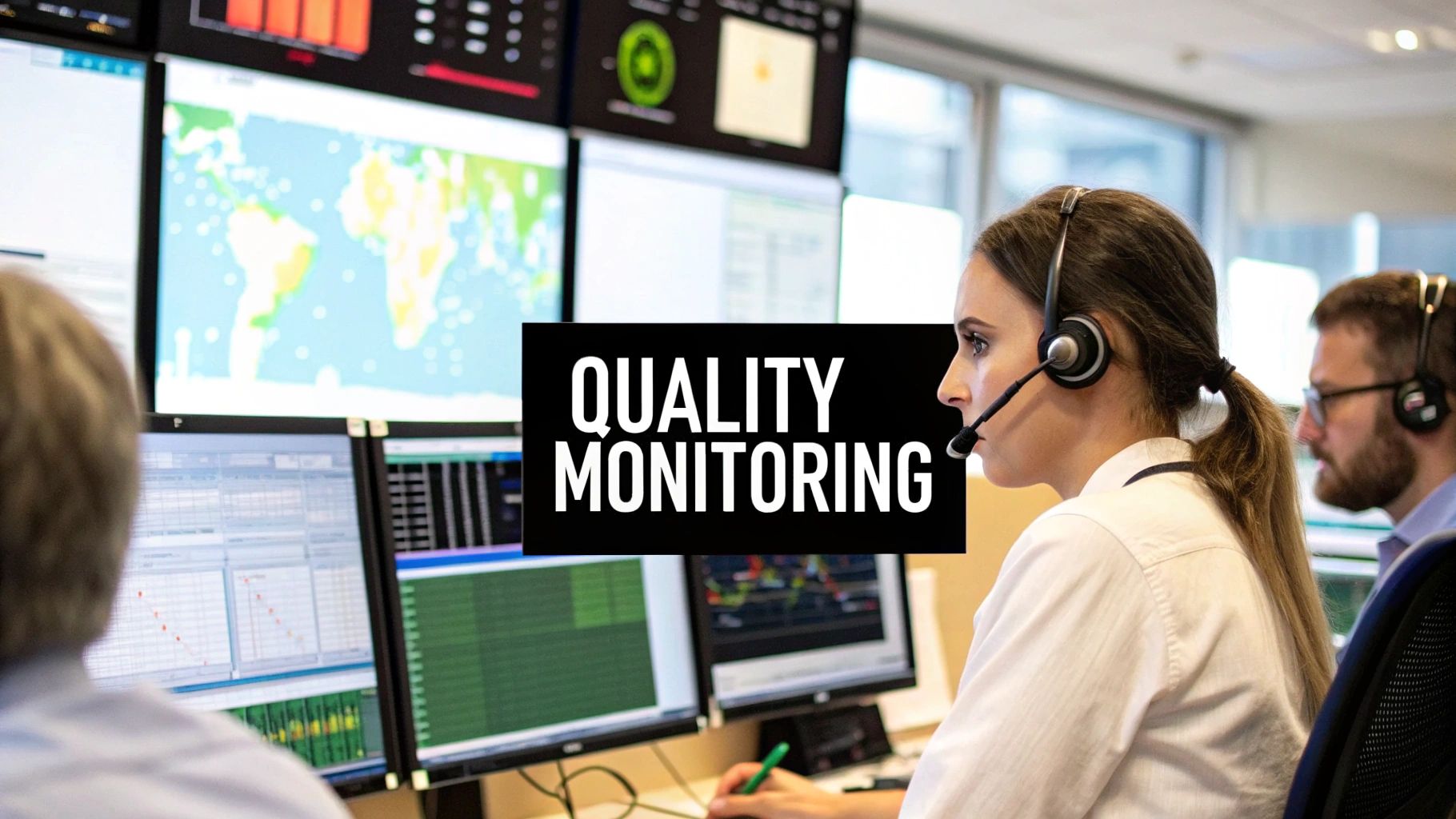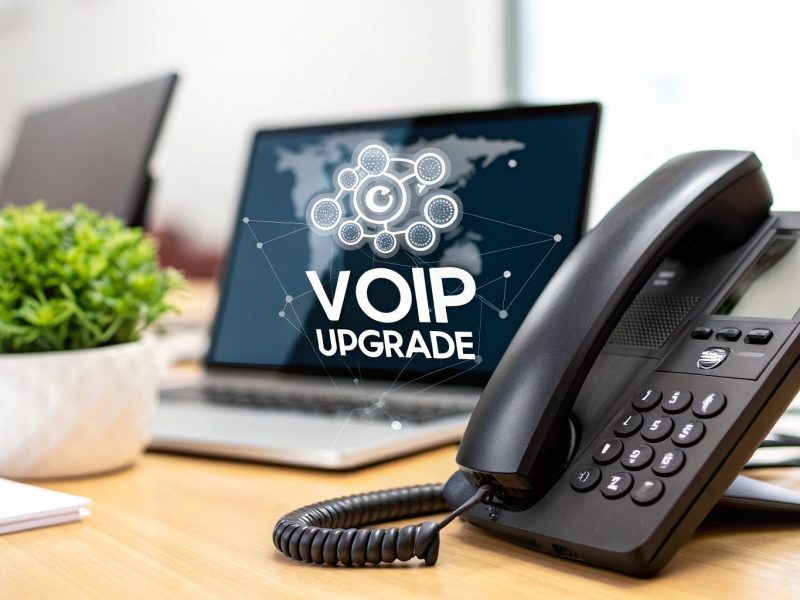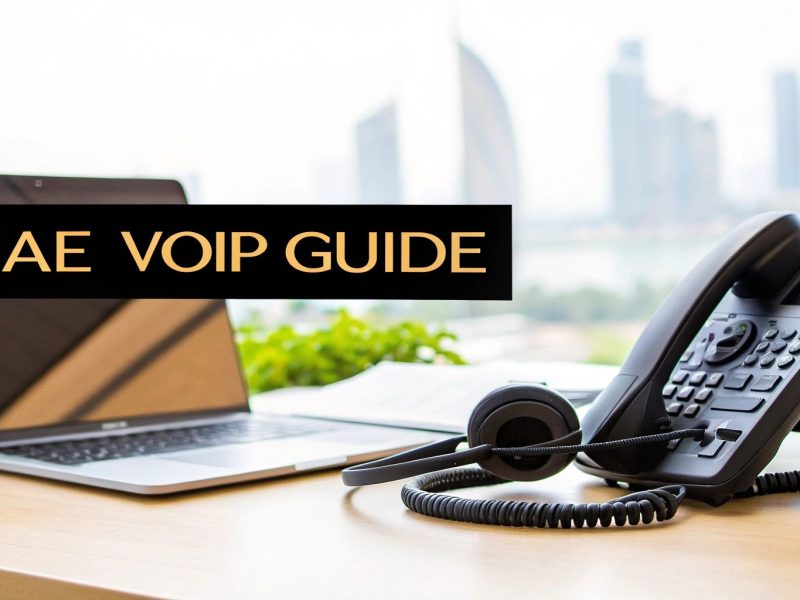Building Your Quality Monitoring Foundation
Call center quality monitoring has evolved. It's no longer a simple checklist; it's the foundation upon which customer satisfaction and operational efficiency are built. This is especially important in the fast-paced Asia-Pacific (APAC) region, where customer expectations are continuously changing. Effective quality monitoring should drive performance improvements, not just create paperwork. This means finding the right balance between measuring efficiency (like Average Handle Time) and evaluating more subtle quality indicators.
To build a strong foundation for call center quality monitoring, explore the key strategies outlined in a comprehensive Call Quality Monitoring Playbook. A solid foundation starts with a deep understanding of what quality truly means for your specific business. It involves aligning monitoring standards with your business objectives and the particular needs of your customer base.
Understanding Regional Nuances
Leading contact centers in Asia are adapting their quality frameworks. They strive to balance universal standards with the region-specific expectations of their customers. This includes understanding cultural nuances, preferred communication styles, and varying comfort levels with digital channels. For instance, customer expectations regarding formality and politeness can differ significantly between Japan and India.
Furthermore, it's crucial to recognize the increasing role of AI in customer service and its effect on call center operations. A key strategy for improving call center quality monitoring in the APAC region is understanding both consumer expectations and barriers to adopting digital support. An InMoment survey of over 1,200 consumers across the Asia-Pacific region highlighted this gap between expectations and current AI capabilities. Learn more about conversational intelligence trends. Often, this gap leads to preventable calls, emphasizing the need for AI that can handle complex issues and provide truly personalized support.
This underscores the importance of incorporating both digital and voice interactions into your quality monitoring process. A robust system must capture what truly matters to customers and drive positive business results across all channels.
The Metrics That Actually Drive Performance
Moving beyond superficial metrics is essential for impactful call center quality monitoring. This requires focusing on Key Performance Indicators (KPIs) that truly reflect both customer satisfaction and agent effectiveness, particularly within the nuanced Asian market. This section explores the key metrics successful call centers in the Asia region prioritize for driving meaningful improvements.
Essential KPIs for Asian Call Centers
Instead of overwhelming agents with an array of metrics, leading call centers concentrate on a select few that consistently predict positive customer outcomes. For example, First Call Resolution (FCR) directly correlates with customer satisfaction. Customers whose issues are resolved on their first call are significantly more likely to be satisfied than those who must call back multiple times. Post-call surveys that provide Customer Satisfaction (CSAT) scores offer additional direct insights into the customer experience.
Understanding what constitutes "good" performance is essential for building a strong foundation. The principles of quality assurance, though focused on chat in this article on Live Chat Quality Assurance, are applicable across different communication channels. These principles emphasize the importance of clear standards and consistent evaluation methods. Simply measuring these metrics isn't sufficient; understanding their interplay and relative importance is crucial.
The infographic below illustrates the crucial relationship between average handle time, customer satisfaction (CSAT), and first call resolution rate (FCR).

As visualized in the infographic, while shorter average handle times can contribute to operational efficiency, they shouldn’t be achieved at the expense of FCR and CSAT. The key to maximizing both customer satisfaction and operational efficiency is striking the right balance between speed and resolution. This means empowering agents to dedicate the necessary time to fully address customer needs, even if it slightly increases average handle time.
To further clarify the metrics and their measurement, consider the following table:
Essential Call Center Quality Monitoring Metrics: A comprehensive comparison of operational versus customer experience metrics with their relative importance and measurement approaches.
| Metric Category | Specific KPIs | Measurement Approach | Impact on Quality | Regional Considerations |
|---|---|---|---|---|
| Operational Efficiency | Average Handle Time (AHT) | Tracking call duration from initiation to termination. | Can positively impact efficiency but should be balanced against FCR and CSAT. | Asian markets may prioritize politeness and thoroughness over speed. |
| Customer Experience | First Call Resolution (FCR) | Monitoring the percentage of calls resolved on the first attempt. | Directly impacts customer satisfaction and reduces operational costs. | Cultural nuances in communication styles may influence FCR rates. |
| Customer Experience | Customer Satisfaction (CSAT) | Post-call surveys and feedback mechanisms. | Provides direct insight into the customer's perception of service quality. | Language barriers and varying cultural expectations of service can impact CSAT scores. |
| Agent Performance | Adherence to Schedule | Monitoring agent's login/logout times and break adherence. | Impacts service level and customer wait times. | Local labor laws and customs should be considered. |
This table highlights the importance of balancing operational metrics like AHT with customer-centric metrics like FCR and CSAT. Regional considerations, particularly within the diverse Asian market, should also influence how these metrics are interpreted and benchmarked.
Setting Benchmarks and Adapting to Change
Establishing realistic benchmarks is vital for continuous improvement. These benchmarks should be tailored to your specific industry, customer base, and the cultural nuances of the Asian region. For instance, customer expectations for formality and response times can vary significantly within the region.
Regularly reviewing and adjusting these benchmarks is crucial, particularly as your business grows and customer preferences shift. Incorporating agent feedback is also essential. Agents are on the front lines, possessing invaluable insights into customer needs and operational challenges. By involving them in the benchmark-setting process, you can create more realistic and attainable goals that drive genuine performance improvements. This collaborative approach cultivates a culture of continuous improvement and empowers agents to take ownership of their performance.
Transforming Monitoring With Next-Gen Technology
The technology driving change in call center quality monitoring is reshaping what's achievable. Leading Asian contact centers are transitioning from limited manual sampling and adopting AI-powered solutions to monitor 100% of customer interactions. This shift is propelled by the demand for richer insights into customer behavior and agent performance, particularly within the ever-changing APAC market.
The Power of AI and Advanced Analytics
This evolution toward comprehensive monitoring is driven by progress in speech analytics and sentiment detection. These technologies extend beyond mere transcription; they delve into the emotional context of every interaction, providing invaluable insights into customer emotions and agent responses. This detailed analysis opens doors to targeted coaching and performance enhancement opportunities that were previously unattainable. Imagine pinpointing the exact phrases or conversational nuances that yield positive customer outcomes, and then empowering your agents to replicate them.
Furthermore, sentiment analysis can identify areas of customer frustration, enabling timely intervention and service recovery.
For instance, consider a customer calling with a complex technical problem. AI-powered speech analytics can not only identify the specific issue but also assess the customer's frustration level based on their tone and word choice. This allows supervisors to provide real-time assistance to the agent, potentially suggesting troubleshooting steps or offering a personalized apology.
Navigating Implementation Challenges in Asian Markets
Implementing these advanced technologies in the diverse Asian market presents unique hurdles. Multilingual capabilities are essential, as are culturally nuanced sentiment analysis models that acknowledge the subtleties of communication across various Asian countries. Securing agent buy-in is also critical. Addressing agent apprehensions about constant monitoring requires transparency and highlighting the benefits of these tools for both agent development and customer satisfaction. Openly communicating how the technology will be used, emphasizing its supportive rather than punitive role, is crucial for successful implementation.
This means investing in platforms that not only comprehend various Asian languages but also accurately interpret customer sentiment within each cultural context. Moreover, addressing data privacy concerns, increasingly vital for customers in the region, is essential for preserving trust and complying with local regulations. Regarding specific quality monitoring metrics, the Asia-Pacific region is increasingly adopting advanced technologies. For example, the contact center quality assurance software market is experiencing rapid growth, with a projected regional market share of 26.9% by 2025, fueled by investments in AI-driven analytics and automation. Find more detailed statistics here
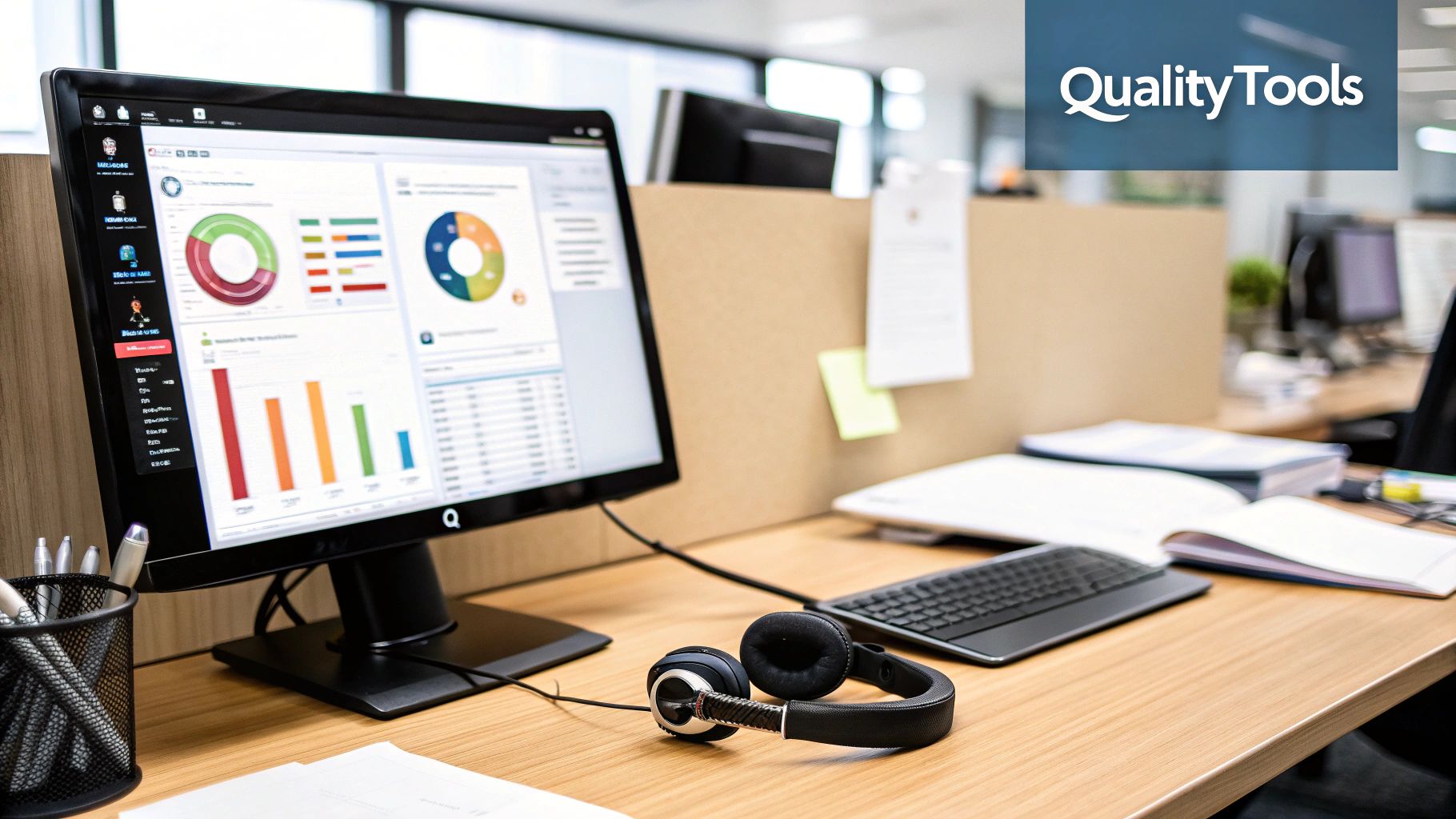
Choosing the Right Technology for Your Contact Center
Selecting the right technology for your contact center demands careful evaluation. It's crucial to assess various solutions and identify those offering genuine Return on Investment (ROI) without adding unnecessary complexity. Key considerations include the platform's scalability, its integration capabilities with existing CRM systems, and the level of ongoing vendor support. Solutions like those from Cloud Move, emphasizing integration and customization, can be particularly advantageous. Their flexible deployment options, accommodating cloud, on-premise, or hybrid environments, enable businesses to adopt next-generation monitoring technology in a way that aligns with their infrastructure and strategic goals. Prioritizing practical implementation and measurable results ensures that your investment translates into tangible improvements in both customer experience and operational efficiency.
Coaching That Actually Changes Agent Behavior
Effective coaching is essential for bridging the gap between call center quality monitoring and tangible agent improvement. However, not all coaching is created equal. Some feedback resonates and drives change, while other feedback falls flat. The key differentiator is how effectively monitoring insights are translated into actionable strategies, particularly within the nuanced cultural context of the AE region.
Delivering Feedback That Motivates
In the AE region, cultural nuances like "saving face" and group harmony significantly influence how feedback is received. It’s not just about what you say, but how you say it. Rather than focusing on individual shortcomings, highlight team successes and frame feedback as opportunities for collective growth. This approach cultivates a supportive environment where agents see coaching as a development tool, not a reprimand.
For instance, instead of saying, “You missed the upselling opportunity,” try, “We’ve noticed our team’s upselling conversion rate could use a boost. Let’s explore some strategies together to achieve this goal.” This subtle shift in focus emphasizes team collaboration and shared responsibility for improvement.
Personalized Development Plans Based on Data
Data from call center quality monitoring should be the foundation for personalized agent development plans. Identify specific skill gaps revealed through monitoring, such as difficulty handling objections or inconsistent script adherence. Then, create targeted training programs to address these areas. At the same time, recognize and build upon existing strengths. This balanced approach acknowledges both areas for improvement and areas of excellence, further motivating agents to develop their skills.
Consider using technology to automate personalized coaching summaries and pinpoint areas for improvement. Advanced AI platforms can analyze 100% of customer interactions, providing valuable data on agent performance. This data reveals areas where agents may need further support or development. Tools like CloudMove offer flexible integrations with popular CRMs, enhancing this approach by consolidating customer interaction data within existing workflows. This streamlined analysis enables the development of actionable, individualized coaching strategies.
Fostering a Culture of Feedback and Peer Learning
High-performing teams actively seek feedback; they don't dread monitoring sessions. To achieve this, cultivate open communication where agents feel comfortable asking for guidance. Implementing peer learning programs further multiplies coaching effectiveness. Encourage agents to share best practices and learn from each other's experiences.
For example, pair high-performing agents with those needing support in specific areas. This collaborative environment builds a sense of shared responsibility for improvement and fosters a supportive atmosphere where agents feel comfortable learning and growing together. This is particularly beneficial in the AE region, given its emphasis on team dynamics and collaborative work styles. By embracing these practices, your team can harness the power of consistent feedback and peer support to drive significant improvements in performance and customer satisfaction.
The Evolving APAC Quality Monitoring Landscape

The Asia-Pacific region presents a dynamic and diverse environment for call centers. Quality monitoring practices must adapt to this constantly shifting landscape. This means understanding the technological advancements impacting the industry and the unique cultural nuances and consumer behaviors of the region.
Cultural Influences on Quality Standards
Cultural preferences significantly influence customer expectations and, consequently, call center evaluation standards across major Asian markets. In Japan, politeness and formality are paramount, emphasizing respectful language, thorough explanations, and building long-term customer relationships.
However, in markets like India and the Philippines, while politeness remains essential, the focus may shift towards efficiency and problem-solving.
These cultural differences necessitate a nuanced approach to call center quality monitoring. A "one-size-fits-all" strategy is inadequate. Evaluation criteria must be tailored to each target market's specific cultural expectations. This requires a deep understanding of local customs and communication styles.
Regulatory Changes and Compliance Monitoring
APAC call centers must also navigate evolving regulatory landscapes. Changes in data privacy laws, consumer protection regulations, and industry-specific compliance requirements demand constant vigilance. Effective quality monitoring must assess customer satisfaction and agent performance and ensure adherence to these crucial legal and ethical standards.
Leading organizations are proactively integrating compliance monitoring into their quality assurance frameworks to minimize risk and reinforce ethical conduct. This evolving regulatory environment requires adaptable solutions. Tools that allow for customizing monitoring criteria and reporting, such as those offered by Cloud Move, are essential for maintaining compliance and minimizing risk.
The Rise of Omnichannel Quality Assessment
The rapid adoption of digital channels is reshaping customer expectations. Asian consumers increasingly demand seamless experiences across various communication channels, from voice and email to chat and social media. This rise of omnichannel communication requires a fundamental shift in quality monitoring frameworks. Traditional voice-centric approaches are no longer sufficient.
This shift towards omnichannel engagement necessitates a holistic approach to quality assessment. Monitoring must extend beyond traditional phone calls to encompass all customer touchpoints, including email, chat, social media, and other emerging channels. This ensures consistent service quality regardless of customer interaction methods. Solutions like those from Cloud Move, designed for multichannel integration and seamless CRM connectivity, are well-suited for this evolving omnichannel reality.
APAC Call Center Market Growth and Technological Advancements
The Asia-Pacific contact and call center outsourcing market is experiencing robust expansion. Projected to achieve a 10% CAGR from 2025 to 2033, the market is expected to reach $24,192.4 million in revenue in 2024. Explore this topic further. This growth is driven by increasing demand for customer service automation and expanding business process outsourcing in the region.
The following table provides a statistical breakdown of quality monitoring technology adoption rates and prevalent approaches across major Asian markets.
APAC Call Center Quality Monitoring Adoption by Country
| Country | Technology Adoption Rate | Dominant Monitoring Approach | Key Quality Challenges | Growth Trajectory |
|---|---|---|---|---|
| Japan | High (85%) | Automated Speech Recognition & Analytics | Maintaining high levels of politeness and formality in digital channels | Steady growth |
| India | Medium (60%) | Hybrid Approach (Manual & Automated) | Balancing efficiency with customer empathy | Rapid growth |
| Philippines | Medium (65%) | Manual Monitoring with increasing adoption of Automated tools | Agent training and development for omnichannel support | Moderate growth |
| China | High (75%) | AI-powered sentiment analysis and chatbots | Data privacy and regulatory compliance | Significant growth potential |
| Singapore | High (90%) | Cloud-based omnichannel quality management platforms | Integration of legacy systems with newer technologies | Steady growth |
This table highlights the varying adoption rates and dominant approaches to quality monitoring across key APAC markets. Japan and Singapore demonstrate high adoption rates, focusing on automated solutions, while India and the Philippines are transitioning towards a hybrid approach. China exhibits a strong emphasis on AI-powered solutions. Across all markets, adapting to omnichannel communication and navigating regulatory landscapes pose significant challenges.
As AI-based analytics and automation become more prevalent, call center operations are poised for continued improvement in efficiency and customer interaction management. This reinforces the importance of adapting quality monitoring strategies to keep pace with this technological evolution and underscores the need for scalable and flexible solutions as the APAC call center market continues its upward trajectory.
Balancing Quality Excellence with Operational Efficiency
Maintaining top-tier quality while simultaneously achieving operational efficiency targets presents a continuous challenge for call centers. This is particularly true within the diverse markets of the AE region, where cultural nuances and varied languages add layers of complexity to the equation. Leading organizations are discovering innovative strategies to address this challenge and deliver exceptional customer experiences without compromising efficiency.
Designing a Tiered Monitoring System
One practical approach involves implementing a tiered monitoring system. Rather than treating all customer interactions uniformly, this system allocates resources based on the inherent complexity and risk associated with each contact. For instance, a straightforward password reset request might necessitate minimal monitoring, whereas a complex technical issue or a customer complaint could require a more comprehensive review. This targeted approach optimizes resource allocation, concentrating attention where it is most crucial.
Strategic Sampling and Calibration
Another valuable technique involves employing strategic sampling to obtain statistically valid insights without the need to review every single interaction. This method allows for a representative overview of call center performance without overburdening quality analysts. Combined with regular calibration sessions, this ensures consistent evaluations across different teams and locations, effectively accommodating regional variations in communication styles and customer expectations.
Right-Sizing Your Quality Program
The scale and scope of your quality program should be tailored to your specific business maturity level and the unique needs of your customer base. A startup with a small team likely doesn't require the same level of monitoring as a large enterprise handling thousands of calls daily. Similarly, customer expectations can differ significantly across various AE markets. For example, customers in some regions may prioritize speed and efficiency, while others might place greater value on a more personalized and in-depth interaction.
Cloud Move recognizes these diverse needs and offers scalable solutions that cater to varying business sizes and customer expectations. Their flexible platform allows for customized integrations with leading CRM systems, empowering businesses to tailor their quality monitoring programs to their specific requirements. This facilitates a targeted and effective approach to quality monitoring that aligns with the nuances of the AE region.
Furthermore, Cloud Move's platform supports multilingual interactions, facilitating accurate monitoring and analysis of calls in the various languages spoken throughout the AE region. This feature directly addresses the challenges posed by linguistic diversity within the call center, ensuring consistent quality and compliance irrespective of the language used.
Adapting to Diverse AE Markets
Adapting to the linguistic and cultural diversity of the AE region is essential. Call center quality monitoring programs must account for variations in language, communication styles, and customer expectations across different markets. This tailored approach ensures that quality standards remain relevant and effective in each specific context. For instance, a call center serving customers in the UAE might employ different quality metrics compared to one serving customers in Saudi Arabia.
By implementing these strategies, call centers can strike a balance between quality and efficiency, delivering a positive customer experience while optimizing operational performance. Cloud Move's platform provides the flexibility and scalability needed to navigate these complexities, offering a robust foundation for success in the diverse AE market.
Implementing Your Quality Monitoring Transformation
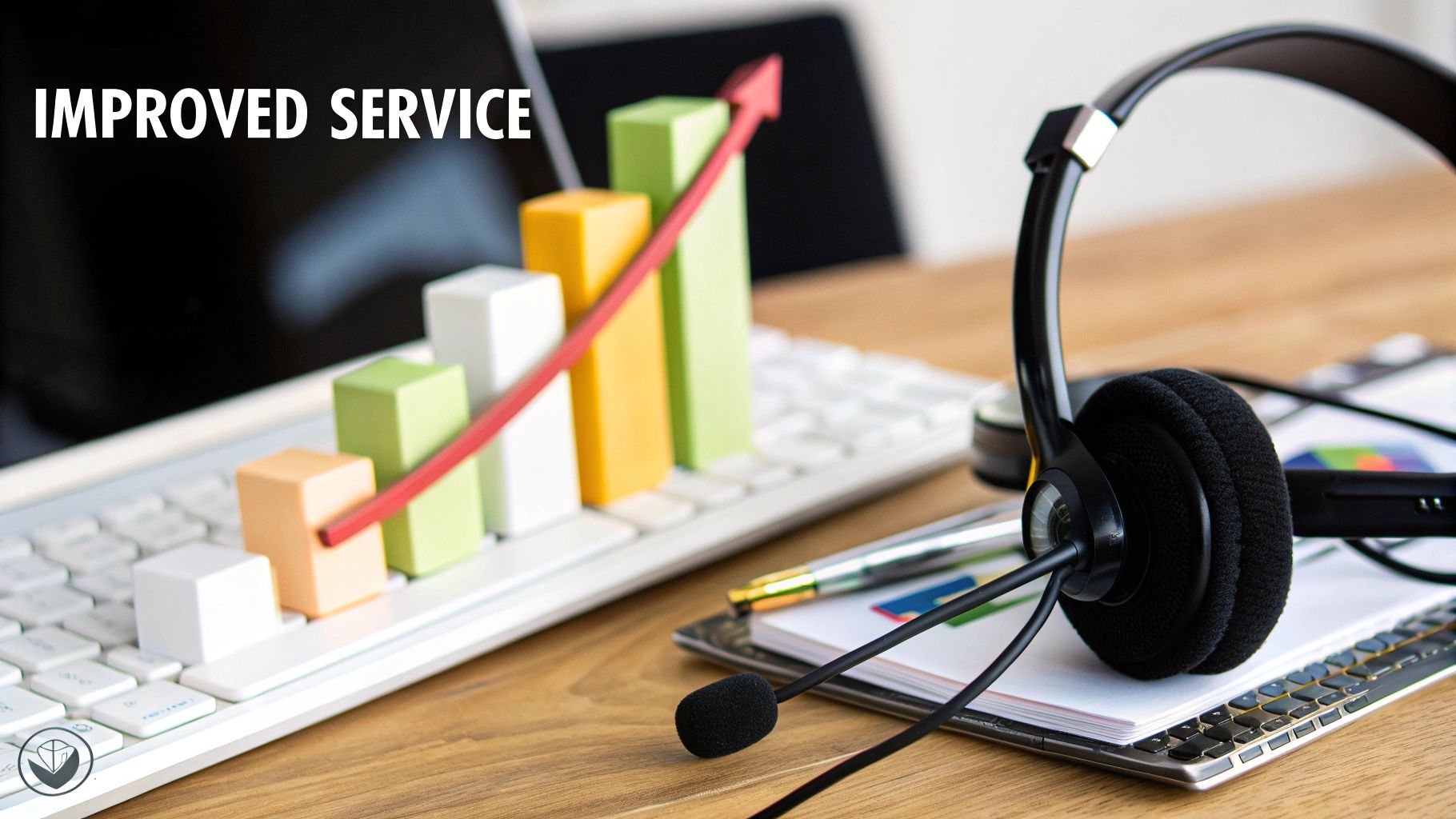
Transforming call center quality monitoring requires a well-defined strategy. It's not simply about implementing new software; it's about cultivating a culture of continuous improvement and demonstrating clear business value. This is particularly important in the AE region, where organizational cultures often prioritize tradition.
Securing Stakeholder Buy-In
Gaining stakeholder buy-in is critical. Demonstrate the business impact of quality monitoring investments by connecting them to tangible results. Show how improved monitoring leads to greater customer satisfaction, increased sales, and reduced costs.
For example, present data linking higher First Call Resolution (FCR) rates to improved customer retention. A data-driven approach justifies the investment and builds support for the transformation.
Pilot Testing and Change Management
Before full-scale implementation, pilot test new frameworks and technologies with a small team. This helps identify potential challenges, refine processes, and gather feedback. Addressing resistance to change, especially in traditional organizations, is also essential.
Clearly communicate the system's benefits to agents and supervisors, emphasizing how it empowers them to improve performance and enhance customer service.
Implementation Roadmap and Timelines
A practical roadmap is essential. It should outline realistic timelines, accounting for potential delays and resource constraints. A phased approach, starting with a pilot program, ensures a smoother transition.
Here's an example:
- Phase 1: Pilot the new monitoring software and frameworks with a small group.
- Phase 2: Expand implementation to other teams, incorporating feedback from the pilot.
- Phase 3: Full-scale rollout across the call center, with ongoing monitoring and evaluation.
Resource Requirements and Critical Success Factors
Outline necessary resources, including personnel, budget, and technology. Consider the number of quality analysts, software costs, and training materials.
Identify critical success factors like effective communication, consistent evaluation standards, and regular calibration sessions. Addressing these upfront ensures a smoother transformation.
Measurable Improvements and Continuous Optimization
Focus on measurable improvements in customer experience and operational performance. Track key metrics like CSAT (Customer Satisfaction Score), FCR, and AHT (Average Handle Time) to assess the transformation's impact.
Regularly evaluate the program's effectiveness and make adjustments as needed. This continuous optimization keeps your quality monitoring program aligned with evolving customer expectations.
Ready to transform your call center's quality monitoring? Contact Cloud Move today for a free demo and discover how our tailored solutions can elevate your customer experience and optimize operational efficiency.


